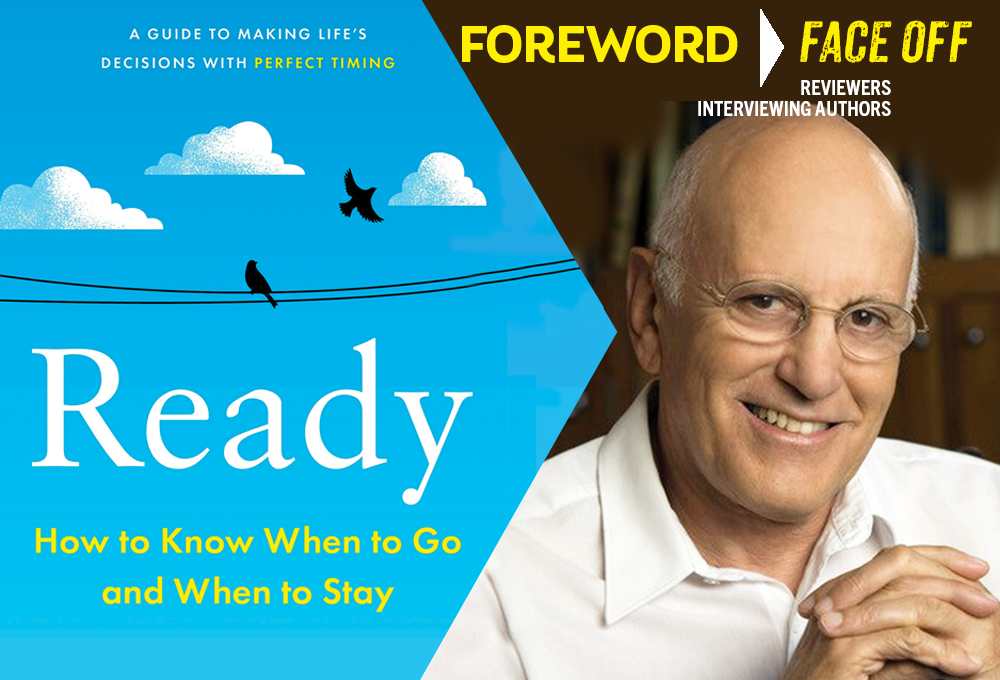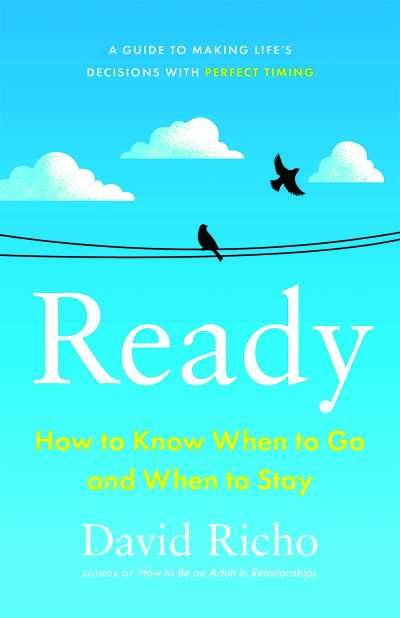It looks like you've stumbled upon a page meant to be read by our code instead of viewed directly. You're probably looking for this page.
Reviewer Rebecca Foster Interviews Dave Richo, Author of Ready: How to Know When to Go and When to Stay

The land of inbetween,
at times it’s all I know.
Wracked by indecision,
should I stay or should I go.
And what lies at the heart of indecision: fear.
With fifty years of experience as a psychotherapist, we’re joined this week by Davd Richo, author of Ready: How to Know When to Go and When to Stay. Fear, Dave says, can “turn us into disbelievers in our capacity to go on, skeptical we can pull off a change, convinced we should put it off indefinitely. Fear dictates to us that we have to wait for more information, wait for a rescuer, wait for someone else to make the first move, such as a partner in a dead-end relationship. We hang back, freeze up, put things on hold, postpone, discard opportunities in favor of procrastination. We may stall, hesitate on the brink, vacillate about what our decision should be, waver about a choice we have approved of mentally.”

Rebecca Foster bestowed Ready with a starred review in Foreword’s May/June issue, and we decisively set up the following conversation—one of our most important interviews ever because Dave shows us the way to overcome that which we fear.
Ready weighs the costs of leaving a situation too soon or staying in it for too long. Are these opposite mistakes, or two sides of the same coin? Do they correlate with pessimism and optimism?
These are opposites. Some of us are afraid to go, that is, move on. Our challenge is to know when it is time to go and then act on what we know. Mostly, we stay put out of inertia. We just keep doing what we are doing. We imagine it takes too much energy to make a change. We fear what change will bring, how it will challenge us.
On the other hand, there are times in life when we don’t stay long enough. We don’t hang in there through thick and thin in a relationship or affiliation that really can work. Our challenge, then, is to know when it is time to stay long enough to upgrade our connection so that it works.
This can be about optimism or pessimism about ourselves and our inner resources. As we trust ourselves more, we allow ourselves to move on or work things out for the better. Our main challenge is to know when it is time to go and then act on what we know.
You helpfully elaborate on distinctions between, for instance, pity and compassion. How can such misunderstood emotions and motives derail us?
We are derailed when we mistake pity for love. We stay in what doesn’t work because we feel sorry for someone. Real compassion is to respond to others’ pain equally as to our own, self-compassion.
Our challenge in all this—and in any issue regarding going—is to find a way to transition supportively. This means we can go and we do so in a way that still stays connected to those we leave behind: “I go on loving you but can’t live with you.” Such a declaration is a full Yes to our own reality while also a full caring for others. It is also how we know that what we say we want, staying, is really what we want—rather than what we believe we should want.
An often overlooked element of pity is remaining aware of our side of it. We know we will feel bad when the other person feels bad. That could be a central motivation for pity. We might stay in a bond because to do so will mean not only that the other person will suffer because we are going but that we will suffer even more watching him do so. In this instance we know the other has tugged at our heart strings and our bond has taken on a sentimental tie that keeps us stuck. The healthy alternative is a relationship in which we are each committed to helping the other face reality squarely. We are not with one another to make it all nice but to keep it all real. Then pity does not figure in while compassion does. Pity stops us both; compassion galvanizes us both.
“Fear is the primary reason we stay stuck,” you write. When is fear useful, and what are some ways we can summon the courage to move past it?
All forms of fear may turn us into disbelievers in our capacity to go on, skeptical we can pull off a change, convinced we should put it off indefinitely. Fear dictates to us that we have to wait for more information, wait for a rescuer, wait for someone else to make the first move, such as a partner in a dead-end relationship. We hang back, freeze up, put things on hold, postpone, discard opportunities in favor of procrastination. We may stall, hesitate on the brink, vacillate about what our decision should be, waver about a choice we have approved of mentally. We might have come to see ourselves as disabled children who can’t possibly cross the rickety bridge from what is to what can be. In fact, we are sure there is no “what can be.” We have sat so long in the ashes of self-discarding that we can’t access our phoenix-soul. We can’t see the new blossoms budding in any vacant lot.
Sometimes our fear of going has an ironic twist. We believe staying put is necessary because we would not make it alone. We are not in touch with our inner resources; we feel more like lost souls than captains of our destiny. We imagine we will be nobody if we are not defined by others or an institution. We rely on what has been, though it does not nurture us, only kept us safe from our terror about launching. A relationship, group, political organization, or cult may pander to that fear and exploit it.
Someday we may build inner resources, gain a sense of personal autonomy, and construct our own framework of suitable beliefs, attitudes, and behaviors. Then we have options, particularly regarding a religious affiliation: We can join a new religion or group, one that fosters freedom. We can leave altogether. We can appreciate that our affiliation has served a purpose but it is no longer applicable. We can then put the institution to one side while remaining in a home-base community of faith, keeping what was positive while no longer having to live under any thumb. Or, we can launch out on our own, while still taking advantage of resources around us. They will, of course, be the ones that respect, cherish, and advance our freedom. No one of these choices is necessarily better than the others. Otherwise we are back in the Lilliputian land of absolutes where Gulliver’s travels come to an abrupt halt.
Some will be surprised to learn that you draw on both Buddhist and Christian spirituality. How do you see the two outlooks as complementary?
Buddhism is a way of life that proposes mindfulness and loving-kindness as ways of living productively. Likewise it suggests letting go as a path out of suffering. Christianity adds the element of grace from a power beyond ourselves. Grace is the gift dimension of life that activates our courage and wisdom. Since Buddhism asks for courage and offers wisdom the two ways of life work hand in hand.
The book closes with a witty take on fairy tale tropes. What inspired you to create this, and what do you hope readers will take away from it?
I wrote the story to bring humor to my topic. Likewise, from the Jungian point of view, fairy tales show us elements of our humanity, both the light and dark sides. In the story we see Snow White in older age and not “living happily ever after.” I took the themes of the book and showed how they might shape up in her story. I also showed how she liberated herself without the help of a man. This is important to bring out the equality of sexes when it comes to accessing inner resources and not staying too long in what doesn’t work.
You’ve been a psychotherapist for more than fifty years. What are some of the things you have learned about human nature, and about yourself, in that time?
I have learned that we all face the same issues in life:
-
How can I feel compassion for myself when I hold back and at the same time ask for the grace to take a step forward?
-
What is making me wait for permission to leave what doesn’t work?
-
How will I feel ashamed or guilty about making a move? How can I put those inhibitions aside?
-
Is there a way to make a choice now rather than waiting for the courage to do so?
-
What fears are holding me back from what comes next on my journey?
-
How can I face my fear and still stand upright?
-
How can I let my fear pass through me like lightning through a lightning rod?
-
How can I let fear go and let freedom in, or rather, out?
-
What will it take for me to believe I will survive making a move, even thrive thereafter?
-
Who are the allies, both mortal and immortal, I can trust to accompany me as I walk through the dark valley?
-
Can I believe I never walk alone?
Rebecca Foster